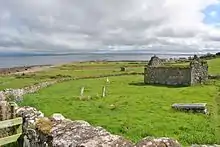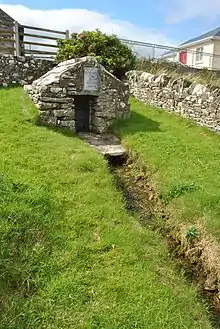St. Cumin of Mayo
Saint Cuimín (also Cummin, etc.) is an Irish saint associated with the parish of Kilcummin (Irish: Cill Chuimín "The church of Cuimín") in the barony of Tirawley, County Mayo. Kilcummin, a headland to the west of Killala Bay, preserves the remains of a religious site, with a church of early date and a graveyard. (54.27713°N 9.21015°W) [1]
Cuimín | |
|---|---|
 Kilcummin's church | |
| Church | Kilcummin |
| Province | Connacht |
| Personal details | |
| Buried | Kilcummin |
History
Cuimín's background is touched upon in a genealogical text compiled by Dubhaltach Mac Fhir Bhisigh (died 1671), who was a member of a learned family from the area around Killala Bay.[2] It names the saint "Cumain Foda" and identifies him as a descendant of Conaing son of Fergus son of Amailgaid, thereby linking him to the leading dynasty in the area,[1][3] the Uí Amolngada.[4] Máire MacNeill suggests that he is probably distinct from another Connacht saint of the same name, Cumméne Fota, who was abbot of Clonfert in the 7th century, although "the coincidence of name and epithet is curious".[1] Pádraig Ó Riain also treats him as a different saint.[2] Dubhaltach also distinguished him from Cuimín mac Dioma (of Uí Suanaig), whose descendants are said to rest at Kilcummin.[5]

While information about Cuimín's life and medieval cult is lacking, there is relatively plentiful evidence for his veneration in early modern and modern times. A holy well at Kilcummin was believed to have healing powers and served as a central place for the patron held in his honour on the last Sunday of July. The day was known as Domhnach Chrom Dubh (in Irish) or Garland Sunday (in English).[1]
Curative powers were also ascribed to earth coming from the saint's grave. The prerogative of administering it to visitors belonged to the Machan (Maughan) or Loughney family, presumably because the family was known to descend from the erenachs (wardens) of the church.[1] A flagstone at the saint's grave known as Leac Cuimín (The stone of Cuimín) is thought to have been used as a 'cursing stone' under similar guidance: members of the Machan (Maughan) or Loughney [6] family could be asked to perform a ceremony to call down maledictions on people who had caused harm to others.[1][7] The practice came to an end in the first half of the 19th century, when a dean by the name of Lyon had it removed "for certain weighty reasons" and built into the wall of the cathedral at Ballina, County Mayo.[7]
Modern folklore tells that Crom Dubh was the cow which revealed the presence of the saintly child by licking a boat on the shore. The child was found inside and he was brought up by a couple named Maughan and Loughney, the owners of the cow.[1][6]
There was a statue with the title "St Cumminskil" in St Brigid Roman Catholic Church in Liverpool, England. The church, located on Bevington Hill, has records dating from 1870 to 1967.[8]
Gallery
 The church of St Patrick and St Cuimín in the parish of Lacken and Kilcummin.
The church of St Patrick and St Cuimín in the parish of Lacken and Kilcummin. St Cuimín over the parish church door.
St Cuimín over the parish church door. The shrine of St Cuimín with father Paddy Hegarty.
The shrine of St Cuimín with father Paddy Hegarty. The headstone on the saint's grave and the ruins of his old church.
The headstone on the saint's grave and the ruins of his old church.
Notes
- MacNeill, The Festival of Lughnasa, p. 611
- Ó Riain, Dictionary of Irish saints, p. 245
- O'Donovan, The Genealogies, Tribes and Customs of Hy-Fiachrach, pp. 8-9
- Charles-Edwards, Early Christian Ireland, pp. 47-48.
- O'Donovan, The Genealogies, Tribes and Customs of Hy-Fiachrach, pp. 44-45
- Lavin, History and legends of the Civil Parish of Kilcummin, p. 20
- "Excursions", 295-298
- "St Brigid Roman Catholic Church, Bevington Hill, Liverpool". The National Archives. Retrieved 2 May 2021.
References
- MacNeill, Máire (1962). The Festival of Lughnasa: A Study of the Survival of the Celtic Festival of the Beginning of Harvest. London: Oxford University Press.
- O'Donovan, John, ed. (1844). The Genealogies, Tribes and Customs of Hy-Fiachrach, commonly called O’Dowda’s Country. Dublin: Irish Archaeological Society.
- Members of the RSAI (1898). "Excursions". Journal of the Royal Society of Antiquaries of Ireland. 28: 283–298.
- Lavin, Seán (1988). History and Legends of the Civil Parish of Kilcummin. Ballina: Ballina Printing Co.
Further reading
- Ó Riain, Pádraig (2011). A Dictionary of Irish Saints. Dublin: Four Courts Press. 245.